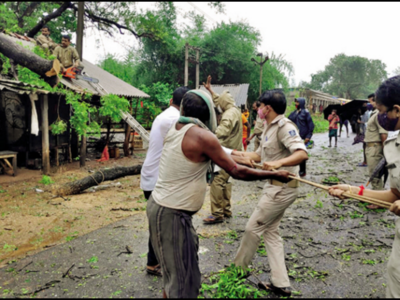- News
- City News
- bhubaneswar News
- Change in atmospheric conditions kept Yaas power low: IMD chief
Change in atmospheric conditions kept Yaas power low: IMD chief

Cops help pull down a tree that fell on a house in Mayurbhanj district on Wednesday
BHUBANESWAR: Cyclone Yaas turned out to be less destructive than was initially predicted because of certain change in atmospheric conditions within the last 24 hours before it made landfall near Balasore on Wednesday.
While the IMD on Tuesday had predicted the storm may fuel wind speed between 155 to 165 km per hour, gusting up to 185 kmph. It later revised the prediction late in the night, 1.45 am, that the maximum speed would be between 130 to 140 kmph gusting up to 155 km. IMD director general Mrutyunjay Mohapatra said the cyclone made landfall with maximum speed of around 130 to 140 kmph.
Mohapapatra said there were two atmospheric conditions that did not favour the cyclone to gain further strength keeping its less powerful than predicted initially. “The vertical wind shear was very high above 20 to 30 nautical miles per hour when the cyclone reached the north Bay of Bengal. The high vertical wind shear that measures change in wind speed in lower and upper troposphere, lowers the storm’s strength,” he said.
Lesser difference in vertical wind shear favours the cyclone. Energy released by the cyclone (very deep convective clouds) gains strength by taking more warm moisture from the local environment on its way. The process continues when the wind difference is low or moderate. But if the difference is high it either weakens the cyclone or doesn’t allow it to gain more strength. There are several reasons behind difference in wind shear.
The difference of less than 10 nautical miles per hour is termed low while between 10 to 20 nautical miles is moderate and above 20 is high. The vertical wind shear was 20 to 30 nautical miles per hour on the cyclone path on Tuesday. “The wind shear was being monitored remotely every three hours. That’s why we revised our prediction late in the night,” Mohapatra said.
Another factor that did not favour the cyclone to be crueller is dry and cold air from north India. It countered the storm’s speed, he said.
While the IMD on Tuesday had predicted the storm may fuel wind speed between 155 to 165 km per hour, gusting up to 185 kmph. It later revised the prediction late in the night, 1.45 am, that the maximum speed would be between 130 to 140 kmph gusting up to 155 km. IMD director general Mrutyunjay Mohapatra said the cyclone made landfall with maximum speed of around 130 to 140 kmph.
Mohapapatra said there were two atmospheric conditions that did not favour the cyclone to gain further strength keeping its less powerful than predicted initially. “The vertical wind shear was very high above 20 to 30 nautical miles per hour when the cyclone reached the north Bay of Bengal. The high vertical wind shear that measures change in wind speed in lower and upper troposphere, lowers the storm’s strength,” he said.
Lesser difference in vertical wind shear favours the cyclone. Energy released by the cyclone (very deep convective clouds) gains strength by taking more warm moisture from the local environment on its way. The process continues when the wind difference is low or moderate. But if the difference is high it either weakens the cyclone or doesn’t allow it to gain more strength. There are several reasons behind difference in wind shear.
The difference of less than 10 nautical miles per hour is termed low while between 10 to 20 nautical miles is moderate and above 20 is high. The vertical wind shear was 20 to 30 nautical miles per hour on the cyclone path on Tuesday. “The wind shear was being monitored remotely every three hours. That’s why we revised our prediction late in the night,” Mohapatra said.
Another factor that did not favour the cyclone to be crueller is dry and cold air from north India. It countered the storm’s speed, he said.
FacebookTwitterLinkedinEMail
Start a Conversation
end of article
Quick Links
Delhi Air PollutionDelhi TemperatureChennai WeatherBangalore TemperatureCovid vaccination centres in DelhiCoronavirus in DelhiRTPCR test in GurgaonHyderabad RainPollution level in BangaloreDelhi SmogDelhi TemperatureNoida AQIGurgaon AQI todayFire in MumbaiMumbai RainsCovid 19 RT PCR Test in NoidaDelhi AQI todaySrinagar encounter
